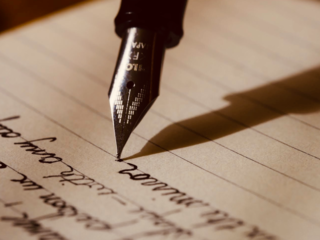I hope you’re relieved: this article is not written in handwriting that will prevent anyone from reading it because it is so bad. None of those crazy loops on the s, or fast, scribbly curves on an a; no unnecessary flourishes on a capital m, or over-extended, elongated tails on a y. Thanks to computers, our society is now able to read every word, number, and punctuation that can be spelled on Google Docs, Microsoft Word, or as the case may be, this website.
In my opinion, technology has created barriers and boundaries that split society into two, separating the advanced digital world from the old fashioned one. Scientific studies show that writing down information in any form is more beneficial than typing it. But, obviously, computers do serve a purpose. We can use them to look up information, explore opportunities, and observe other lives. And, yet, we can’t completely revoke pen and paper. We can learn just as much (if not more) from books as we can with computers.
People typically choose to type instead of write due to speed and legibility. The scribbled words and sentences might make sense one minute, but not the next. And if you’re trying to cram in a study session for a physics quiz the next day, unreadable notes are…well….unreadable.
The classifications between “good” and “bad” handwriting boil down to whether you can read it or not. You could hand it to your friend and ask what it says. If they struggle to decipher the words, then it would be considered “bad.”
According to The National Handwriting Association, we can actually determine a person’s personality by interpreting their writing. This is called graphology. Everyone’s handwriting is different. For example, I might write the word potato differently than you write it. But how I write it- and how you write it- reflect what is unique about each of us. The British Institute of Graphologists says that each aspect of every letter in each word shows our personality.
Unfortunately, Graphology is not perfectly factual. The British Institute of Graphologists explains that, “Graphology is a blend of art and science. It is a science because it measures the structure and movement of the written forms – slants, angles and spacing are accurately calculated and the pressure is observed in magnification and with precision. And it is an art because the graphologist has constantly to keep in mind the total context in which the writing is taking place.” While we cannot pinpoint the origin of our handwriting, we do know that the way we use it expresses our emotions, personality, and character.
Recently, I looked at my mother’s handwriting and my father’s handwriting, and found that there are no similarities between their handwriting and mine. Theirs are messier, but also more professional and adult looking. Mine looks like a high school student who is trying to make their work look organized and pretty. Likely because I am.
Genetics contributes to the specific way you hold your pencil to the way your eyes interpret the words on the paper. According to Live Science, “… genetics also play a role in shaping how a person dots their i’s and crosses their t’s. Handwriting is influenced by a person’s anatomy, for example, bone structure affects how one holds a pen. Hand-eye coordination, muscle memory and mental ability in copying proper penmanship also influence writing….Handwriting can change over time as these physical and mental characteristics change.”
In this case, my father’s handwriting would be more developed because his hand bones are more developed. Or, his hand eye coordination is more practiced and experienced than mine because he is older than me.
The small, everyday activities and events of our lives- every moment and every second- play a huge role in everything we do. Your handwriting could be sloppier if you are angry or neater if you feel happy and committed to your work. Who knows? Without genetics and personality, your handwriting might have been ten times worse than it already is.
Here are some “examples” of handwriting analysis. Please note that these were not performed by real experts.

Age: 11
Personality: Overall, this person is completely whimsical and acts focused, but is actually very distractible.
Facts About Them: A person who has handwriting like this is almost definitely a middle child. Their birthday is in late March, and they seem like the kind of person who would have had a Harry Potter obsession as a child. This person likely has a garden, but the only thing they have been able to grow is carrots.

Age: 18-21
Personality: This person has an indecisive personality. They have a bunk bed, but can never decide whether to sleep on the top or the bottom. Or actually, maybe the floor.
Facts About Them: This handwriting gives off genius vibes: almost like the next Albert Einstein. As a child, this person enjoyed playing in the sandbox for a snack of the sand. This child LOVED eating slime.

Age: 18-22
Personality: They are forgetful and often very clumsy. (To the extent where they drop things 24/7)
Facts About Them: This person is giving college kid vibes that is trying to be professional. They have a lot of fish which they feed for the first few weeks, but then ignore so that they die. Every time they are committed to ensuring that their fish live until they give up. Their thoughts are really important, so they are always in a rush to jot things down, which implies a future as a doctor.








